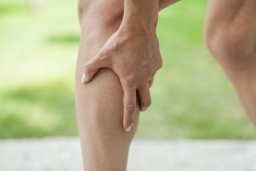Exercise Associated Muscle Cramping
Wednesday, April 1, 2015 - 09:00

Muscle cramps are a common occurrence in sports and numerous other physical activities, where even highly fit athletes can experience slight to very painful muscle spasms. Any muscle can be affected but it commonly occurs to the legs, for athletes this can be debilitating and require some time off from training and competition. Theories are mixed in the scientific community as to why muscle cramping occurs, although muscular fatigue is currently thought as the most likely cause.
How to avoid muscle cramps:
- Fatigue can play a factor in cramping thus being well rested and recovered before a heavy bout of training can minimize it.
- Maintain proper fluid intake especially in hot/humid conditions.
- In the latter parts of exercising be aware of intensity changes from easy efforts to hard efforts as cramping can occur during these changes.
- Replacing fluids and electrolytes (sodium, chloride, potassium, calcium, magnesium) after hard intensity exercise is best absorbed through food. So eating a meal while consuming liquids can optimize fluid consumption.
- The more fit you are the less likely you will experience muscle cramps.
Muscles cramps are commonly associated with excessive sweat loss and low sodium levels. Studies on fluid loss and cramps have had mixed results although maintaining adequate hydration levels is always a good idea. For those suffering muscle cramps due to excessive fluid loss and low sodium, consuming fluids with added sodium can be beneficial.
For coaches, the best way to minimize muscle cramping from occurring to your athletes is to educate them on the importance of fluid intake, proper recovery and stretching. Encouraging hydration before, during and after exercising is critical in preventing injuries in order to maintain the consistent training needed to build proper fitness. Though water can be sufficient in most cases, sweat loss can lower sodium levels and encouraging sports drink intake, especially for endurance athletes, can be important.
When you experience muscle cramps, it’s recommended that all activity stops because you are more likely to feel the cramp again. The best way to ‘treat’ a muscle cramp is with rest, stretching and icing of the affected area. If the cramp is particularly severe, it’s recommended that you seek out the advice of a specialist.
References from the SIRC Collection:
Bergeron M. Muscle Cramps during Exercise -- Is It Fatigue or Electrolyte Deficit?. Current Sports Medicine Reports (American College Of Sports Medicine). July 2, 2008;7(4):S50-S55.
Cause of Exercise Associated Muscle Cramps (EAMC) — altered neuromuscular control, dehydration or electrolyte depletion?. British Journal Of Sports Medicine. June 2009;43(6):401-408.
Eichner E. The Role of Sodium in 'Heat Cramping.'. Sports Medicine. February 15, 2007;37(4/5):368-370.
MUSCLE CRAMPING IN ATHLETES-RISK FACTORS, CLINICAL ASSESSMENT, AND MANAGEMENT. Sportex Dynamics. April 2008;(16):5.
Schwellnus M, Drew N, Collins M. Increased running speed and previous cramps rather than dehydration or serum sodium changes predict exercise-associated muscle cramping: a prospective cohort study in 210 Ironman triathletes. British Journal Of Sports Medicine. July 2011;45(8):650-656.